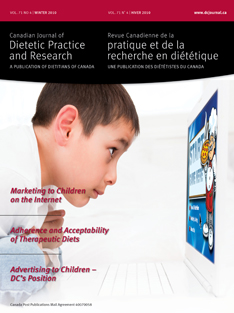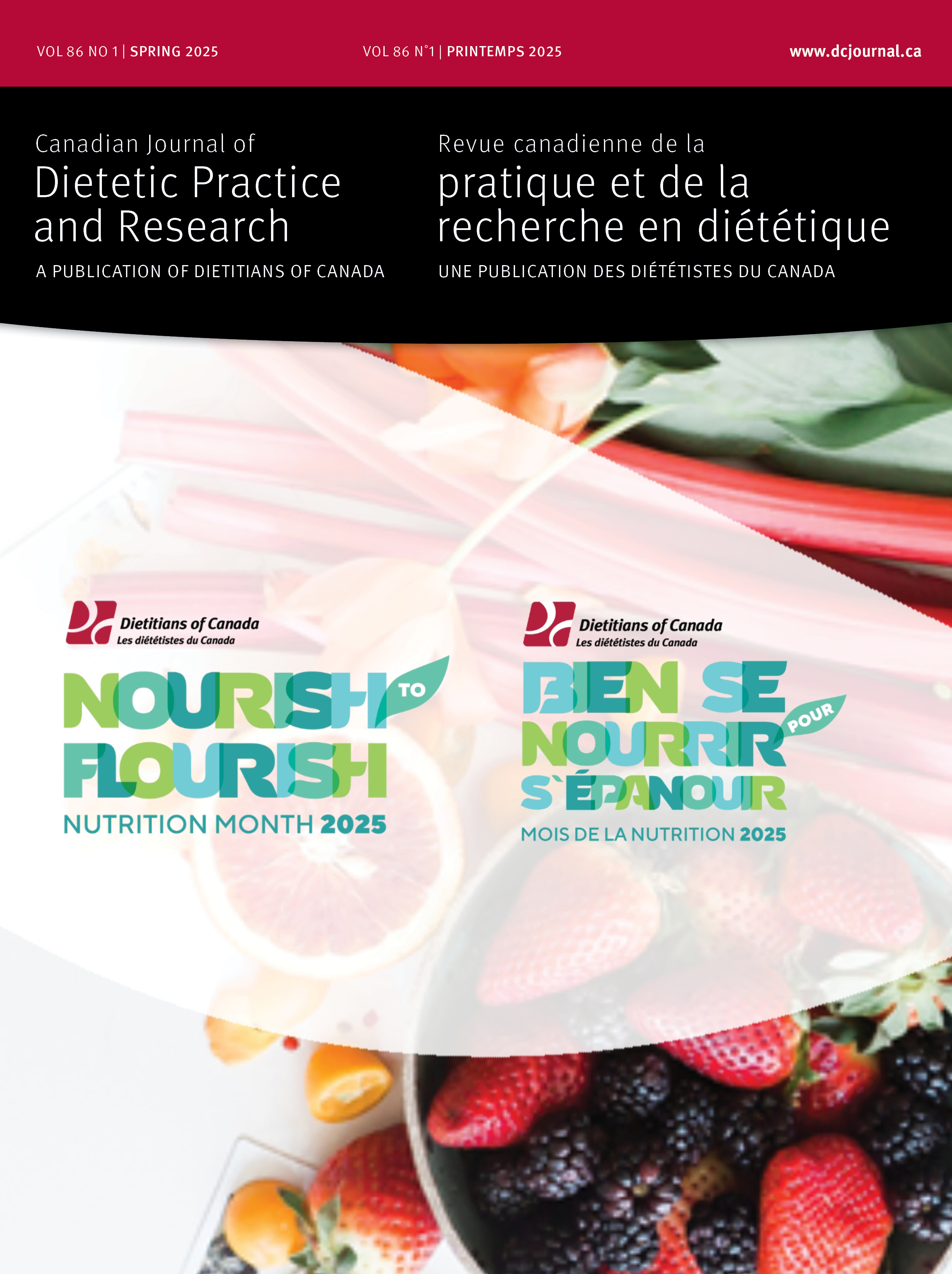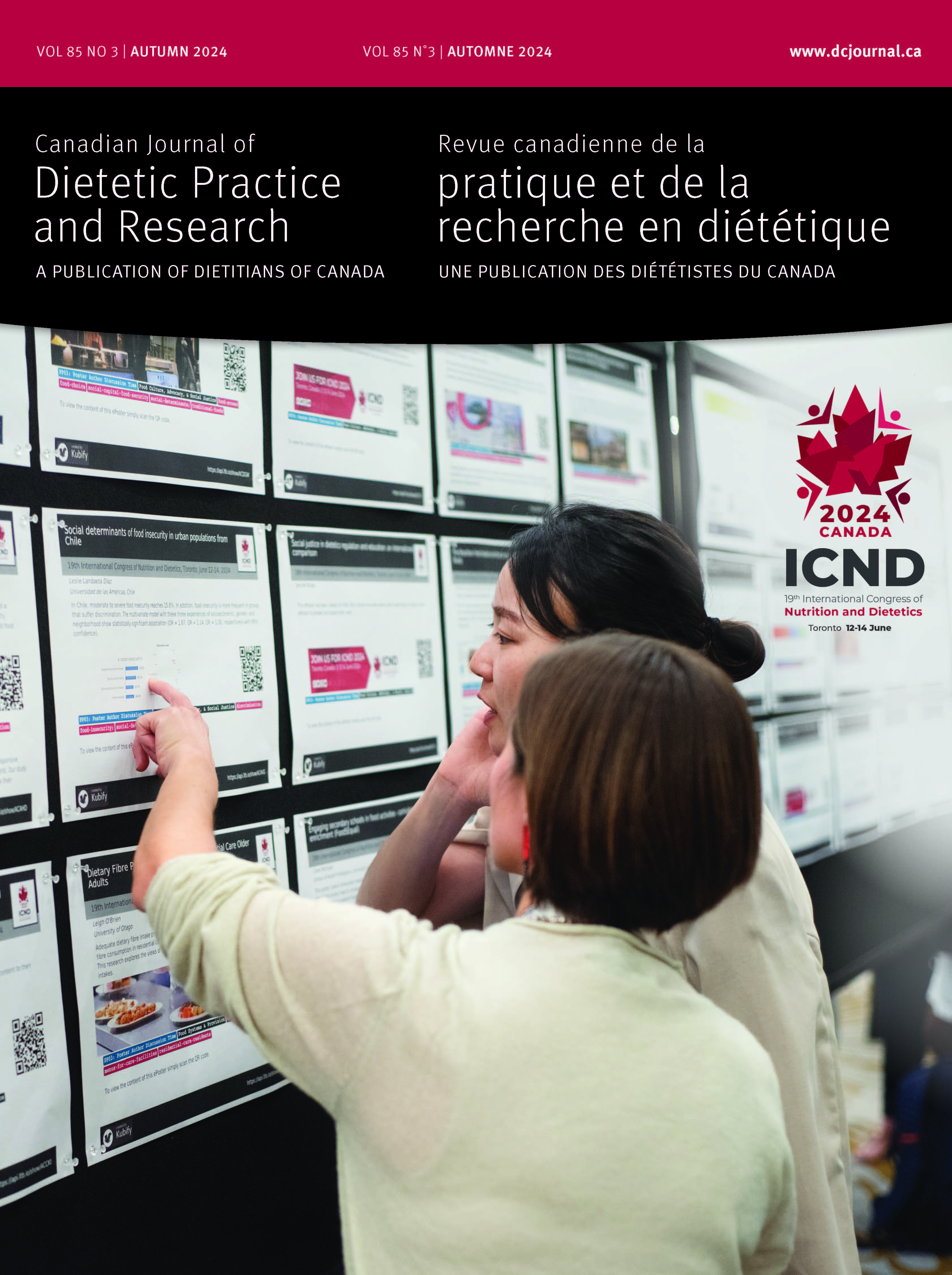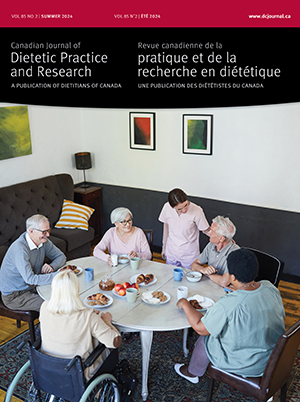Volume 71 • Number 4 • December 2010
Chair’s Message
Editor’s Message
Research
Purpose: The goal was to assess websites sponsored by food and beverage manufacturers that have pledged to market branded food and beverage products to children responsibly, by ratifying the Children’s Food and Beverage Advertising Initiative (CFBAI). Methods: A content analysis was conducted of 24 purposively sampled websites sponsored by 10 companies that promote food and beverage products to children. All are participant members of the CFBAI. Results: Of the 24 websites analyzed, the majority targeted children below age 12 (83%). An array of innovative online marketing techniques, most notably free website membership (63%), leader boards (50%), adver-games (79%), and branded downloadable content (76%), were used to encourage children’s engagement with branded food and beverage promotions. Conclusions: Food and beverage manufacturers are engaging children with dynamic online marketing techniques that challenge regulatory codes governing broadcast media. These techniques may contradict the spirit of the CFBAI. Innovative regulatory guidelines are needed to address modern marketing media.
Purpose: We explored parent and student perceptions of barriers and facilitating factors influencing the implementation of school nutrition policies (SNPs). Specifically, we focused on the changes made to the school food environment and the acceptance of those changes. Methods: This paper is a report on the first phase of the qualitative component of a larger five-year evaluation of nutrition policies in Prince Edward Island elementary schools (grades 1 to 6) and consolidated schools (grades 1 to 8). Focus groups were conducted with 41 students from four schools, and indepth interviews were conducted with 12 parents. Interviews were transcribed and coded; analysis was informed by interpretive description. Results: Four themes were identified as barriers to effective implementation: inadequate communication with parents and students about the policy and menu changes, limited school resources and volunteers, role/responsibility conflict concerning the feeding of children, and student food preferences. The main facilitating factor was parental and student support for healthy eating at school. Conclusions: Study results add to the limited body of knowledge about stakeholder perceptions during early implementation of Canadian SNPs. Dietitians can foster communication, engagement, and education of stakeholders, which will increase the likelihood that students and their families will accept SNPs.
Purpose: In this cross-sectional descriptive study, we explored the relationship of parental feeding practices and child physical activity levels with measured body mass index (BMI) in a sample of 97 Ontario preschoolers. Methods: Child weight and height were measured; physical activity and sedentary behaviours were assessed by questionnaire. Preschoolers’ parents used the Child Feeding Questionnaire to report their attitudes, concerns, and practices in relation to child feeding. Hierarchical multiple linear regression was used to determine relationships among variables. Results: Up to 25% of the preschoolers were overweight and/or obese. The regression model accounted for 53% of the variance in child BMI. Child BMI was predicted to be higher when parents had concerns about and perceived their children to be overweight, and when they felt responsible for what their children ate. Children's BMIs were predicted to be lower for those whose parents pressured them to eat and also for those who engaged in organized sports or activities. Conclusions: This study suggests an association between BMI and parental perceptions, concerns, and practices related to child feeding and organized sports or activities. Public health initiatives related to healthy eating and/or obesity prevention should include a focus on parents of preschool-aged children with the home environment as a potential setting.
Purpose: Recreation facilities (RFs) provide physical activity environments; however, unhealthy food choices are abundant there. This needs assessment was conducted to determine patrons’ satisfaction with food and purchasing preferences while at RFs, reasons for purchasing certain foods, and inclination for other options. Also assessed were RF operators’ receptiveness to and perspectives on the feasibility of providing healthy foods. Methods: A previously developed and piloted paper-andpencil survey was administered to a cross-section of 269 adult patrons of local RFs. Seven operators participated in a previously developed researcher-administered survey. Results: Among patrons, 52.2% were satisfied with RF food choices, although 59.2% and 68.8% reported not purchasing any RF food or beverages from the snack bar or vending machines, respectively. Patrons who were dissatisfied and did not purchase food and beverages noted the abundance of unhealthy choices, poor food quality and variety, and expense as reasons. All operators were interested in and receptive to healthy food options at their RFs, but expressed concerns about poor sales of existing healthier options. All operators indicated the importance of knowing what patrons would purchase. Conclusions: The RF operators and most patrons were interested in and receptive to healthier food options at RFs. Developing, implementing, and evaluating a pilot RF healthy-food intervention are next steps.
Purpose: The Healthy Vending Machine Pilot Project (HVMPP) was a public health initiative intended to create a healthier school nutrition environment by making healthier snacks available in vending machines, while maintaining a profit margin. The HVMPP was evaluated using quantitative and qualitative measures. Methods: Vending machines were stocked with healthier choices and conventional vending products at a 50:50 ratio. The HVMPP was implemented from February to May 2007 in four Ontario secondary schools in Middlesex-London, Elgin, and Oxford counties. Product sales were tracked, and focus groups were conducted to obtain students’ opinions about healthy eating and vending choices. Results: “Healthier choice” sales ranged from 14% to 17%. In all schools, vending revenues declined from 0.7% to 66%. A majority of participants had substantial knowledge of healthy eating and were in favour of healthier choices in vending machines; however, price, value, and taste were barriers that led them to purchase these products rarely. Students preferred to have “real” healthy snacks, such as yogurt, fruit, and vegetables, available in schools. Conclusions: Replacing 50% of vending stock with healthier snacks resulted in a decline in vending revenues. Future health programs in schools need to provide “real” healthy snacks, such as low-fat dairy products, fruits, and vegetables.
Purpose: The aim was to develop a strategy for evaluating food sensory quality in an institutional setting, the Parameter Specific Sensory Quality (PSSQ) approach, and to compare the inter-evaluator judgement concordance (IEC) using the PSSQ tool versus a traditional tool (TT). Methods: Inter-evaluator judgement concordance was assessed before and after participants underwent 12 (Study 1) or eight hours of training (Study 2). In Study 1, the IEC was determined before training using the traditional tool only (29 food items) and after training using both the traditional tool and the PSSQ (28 food items). In Study 2, the IEC was determined before and after training using the PSSQ (19 food items). Intraclass correlation coefficients (ICCs) were used to measure the IEC, and data were compared using Fisher's transformation. Results: Study 1 highlighted the poor IEC for the traditional tool in general (ICCpre=0.41 vs. ICCpost=0.43; p>0.1), especially in comparison with that for the PSSQ (ICCPSSQ=0.88 vs. ICCTT=0.43; p<0.01). Study 2 corroborated the excellent performance of the PSSQ, even when participants had as few as eight hours of training (ICCpost=0.93). Conclusions: The inter-evaluator judgement concordance in the evaluation of food sensory quality is fundamental to the generation of valid and useful information. Study results suggest that the food sensory IEC could be improved in hospital settings through the use of a parameter-specific approach, and that this improvement could help ensure the provision of foods of consistent quality.
Review
Many health conditions are treated, at least in part, by therapeutic diets. Although the success of any intervention depends on its acceptability to the patient, the acceptability of therapeutic diets and factors that influence it have been largely neglected in nutrition research. A working definition of acceptability is proposed and an examination and summary are provided of available data on the acceptability of common diet regimens used for medical conditions. The goal is to suggest ways to improve the success of therapeutic diets. The proposed working definition of “acceptability” refers to the user's judgment of the advantages and disadvantages of a therapeutic diet—in relation to palatability, costs, and effects on eating behaviour and health—that influence the likelihood of adherence. Very low-calorie, reduced-fat omnivorous, vegetarian and vegan, and low-carbohydrate diets all achieve acceptability among the majority of users in studies of up to one year, in terms of attrition and adherence rates and results of questionnaires assessing eating behaviours. Longer studies are fewer, but they suggest that vegetarian, vegan, and reduced-fat diets are acceptable, as indicated by sustained changes in nutrient intake. Few studies of this length have been published for very low-calorie or low-carbohydrate diets. Long-term studies of adherence and acceptability of these and other therapeutic diets are warranted.
An evidence-based review of research on obesity prevention and treatment in youth was conducted to identify successful elements of community nutrition interventions. Guidelines for dietetic practice appropriate to this age group were synthesized. Following a systematic review of English-language research papers published from 1996 to 2009, 63 interventions met inclusion criteria and were graded according to methodological quality, quantity, consistency, and reproducibility. They also were analyzed for common themes and used to develop guideline statements and a practice algorithm. A national panel of experts in community nutrition, public health, adolescent health, academia, and endocrinology assessed the guidelines and the practice algorithm for validity, acceptability, and applicability. Successful prevention strategies are comprehensive, address social and environmental influences, include nutrition education and physical activity, and use schools as a health promotion delivery venue. Computer- or technologybased and peer-modelling strategies are promising, developmentally appropriate approaches. Effective obesity treatment strategies utilize diet plans and behaviour modification techniques, and involve families in intensive, multidisciplinary interventions. Given the distinct needs of this age group, healthy body weight must be promoted through a comprehensive school-based approach. In summary, obesity prevention and treatment interventions should be comprehensive, multidisciplinary, and developmentally appropriate.
Il est reconnu que les personnes âgées vivant en hébergement constituent une population à risque de souffrir de déshydratation. Un apport insuffisant en eau contribue au maintien d'un état d'hydratation sous-optimal, affectant la qualité de vie et l’état de santé. Selon les résultats des études recensées, entre 32 et 96 % des résidents des centres d'hébergement avaient des apports insuffisants en eau, et plus de 50 % consommaient moins de 1,5 l de boissons et d'eau par jour. Les facteurs de risque contribuant à limiter l'apport en eau des résidents se divisent en deux catégories, selon qu'ils touchent l'individu ou l'environnement social et institutionnel. L'apport en eau des résidents est associé aux repas et à l'administration des médicaments. La diminution de la perception de la soif, le refus volontaire de boire, la dysphagie et la dépendance fonctionnelle sont les facteurs individuels identifiés contribuant le plus à la diminution des apports hydriques. Le manque de soutien familial et de ressources humaines est également un facteur important puisqu'il réduit l'assistance offerte. Les diététistes jouent un rôle capital dans le maintien d'un bon état d'hydratation des résidents en identifiant les facteurs de risque pouvant compromettre les apports hydriques et en assurant l'implantation de mesures correctives appropriées.










